Abstract
Integrins are cell-surface heterodimers formed by the association of one alpha- and one beta-subunit. Glycoprotein IIIa (GPIIIa or beta 3 subunit) is the common beta-subunit of the beta 3 subfamily of integrins, which, when associated with glycoprotein IIb (GPIIb), constitutes the receptor for fibrinogen and other adhesive proteins at the platelet surface (the GPIIb-IIIa complex) and, when associated with the alpha v-subunit, constitutes the vitronectin receptor present in several cell types. Protein chemical analysis of GPIIIa allows us to define the following structural domains: the cysteine-rich and proteinase-resistant N-terminal domain (GPIIIa 1-62); the adhesive-protein-binding domain (GPIIIa 101-422); the cysteine-rich and proteinase-resistant core (GPIIIa 423-622); and the C-terminal domain comprising an extracellular subdomain (GPIIIa 623-692), a transmembrane subdomain (GPIIIa 693-721), and a cytoplasmic subdomain (GPIIIa 722-762). We also assign unambiguously the disulphide bonds within the N-terminal, the fibrinogen-binding and the C-terminal domains, and the two long-range disulphide bonds which join the N-terminus to the proteinase-resistant core (Cys5-Cys435) and the fibrinogen-binding domain to the extracellular side of the C-terminal domain (Cys406-Cys655). In addition, we propose three alternative models for the arrangement of the disulphide bonds within the core and of the disulphide bonds joining the core to the extracellular side of the C-terminal domain, consistent with our experimental findings, favouring temporarily that which imposes less steric hindrance for the formation of these disulphide bonds. On the basis of this information and on the highly conserved overall structure observed in the beta-subunits of the integrin family known so far, except in beta 4, we propose to extend the cysteine-pairing pattern and the structural domains outlined here for GPIIIa to all the beta-subunits of the integrin family.
Full text
PDF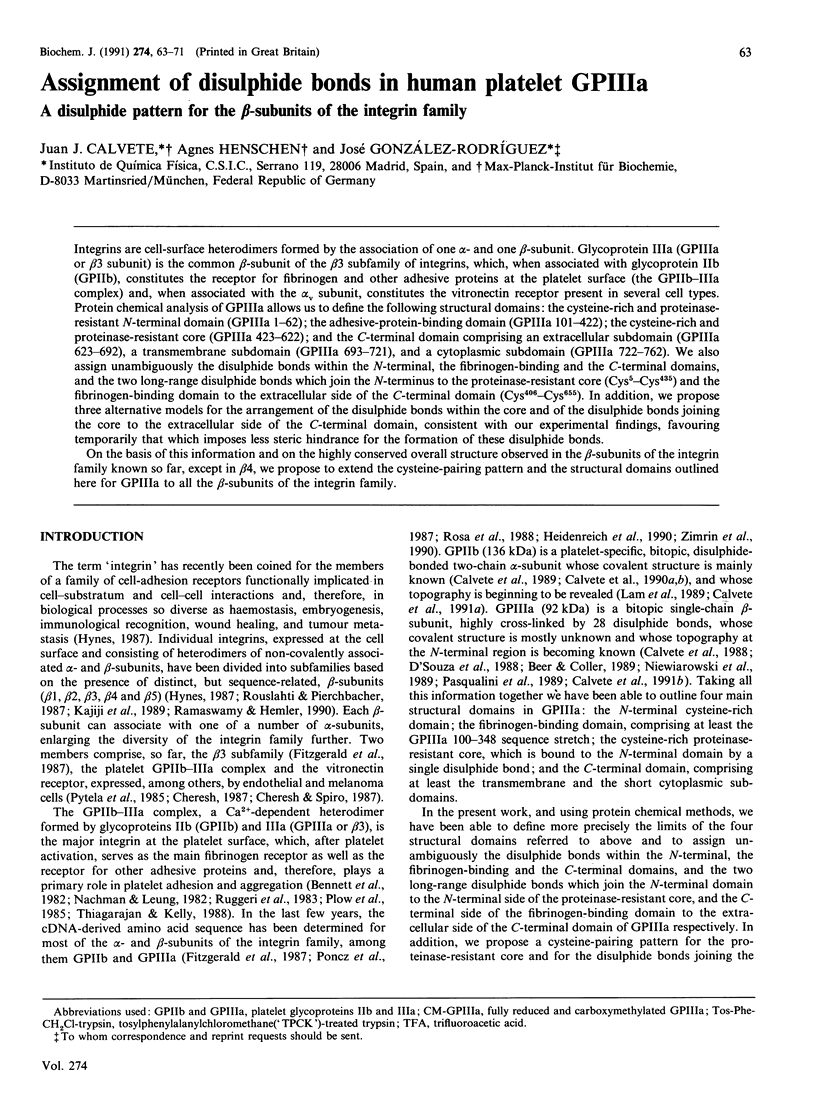
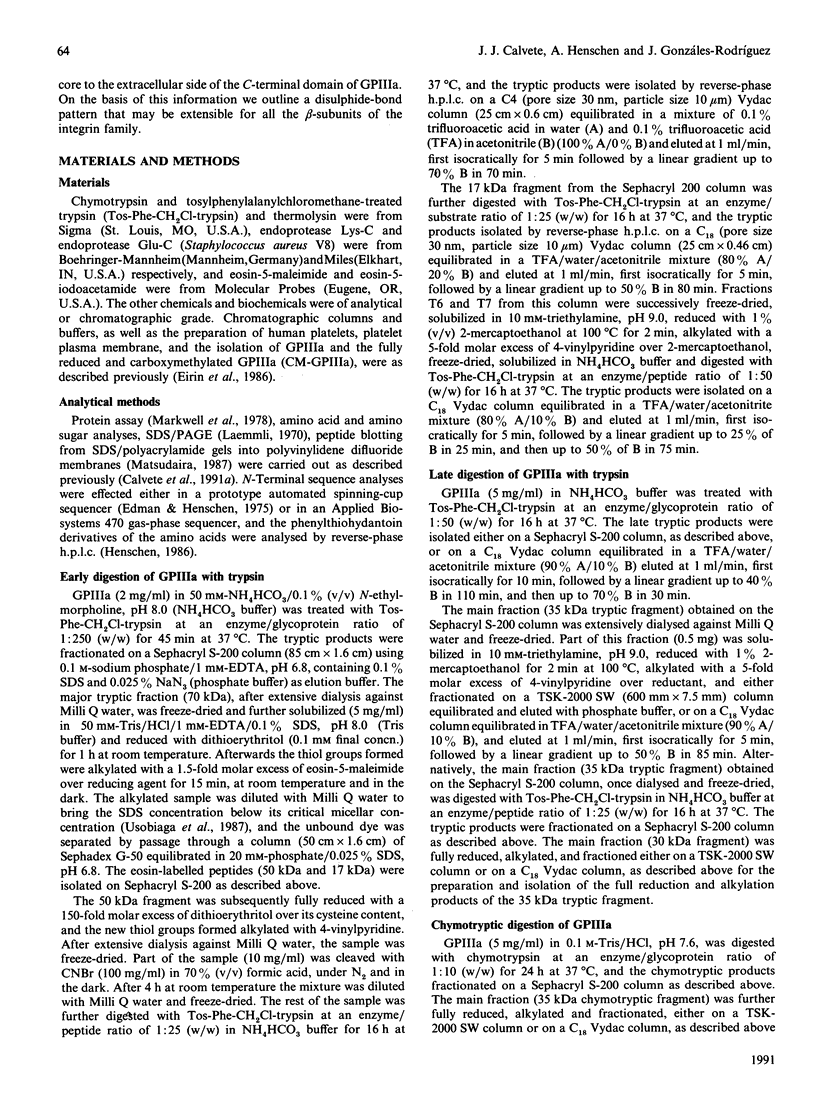
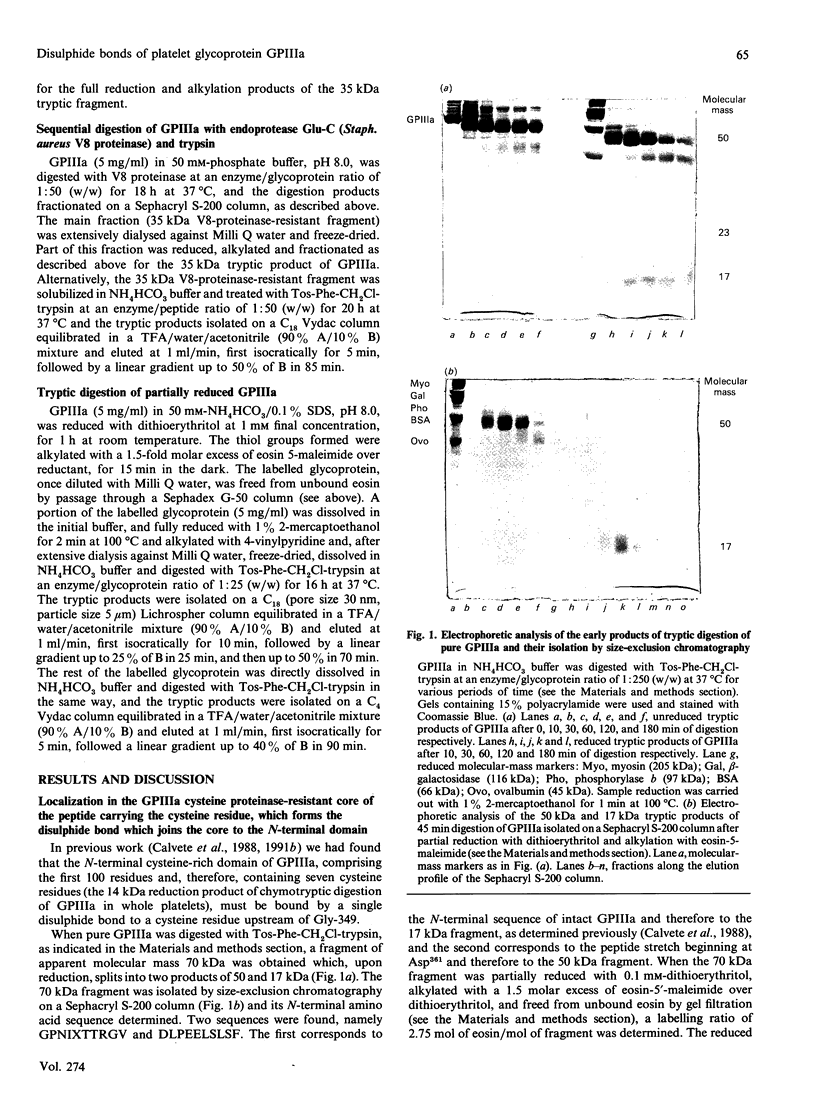
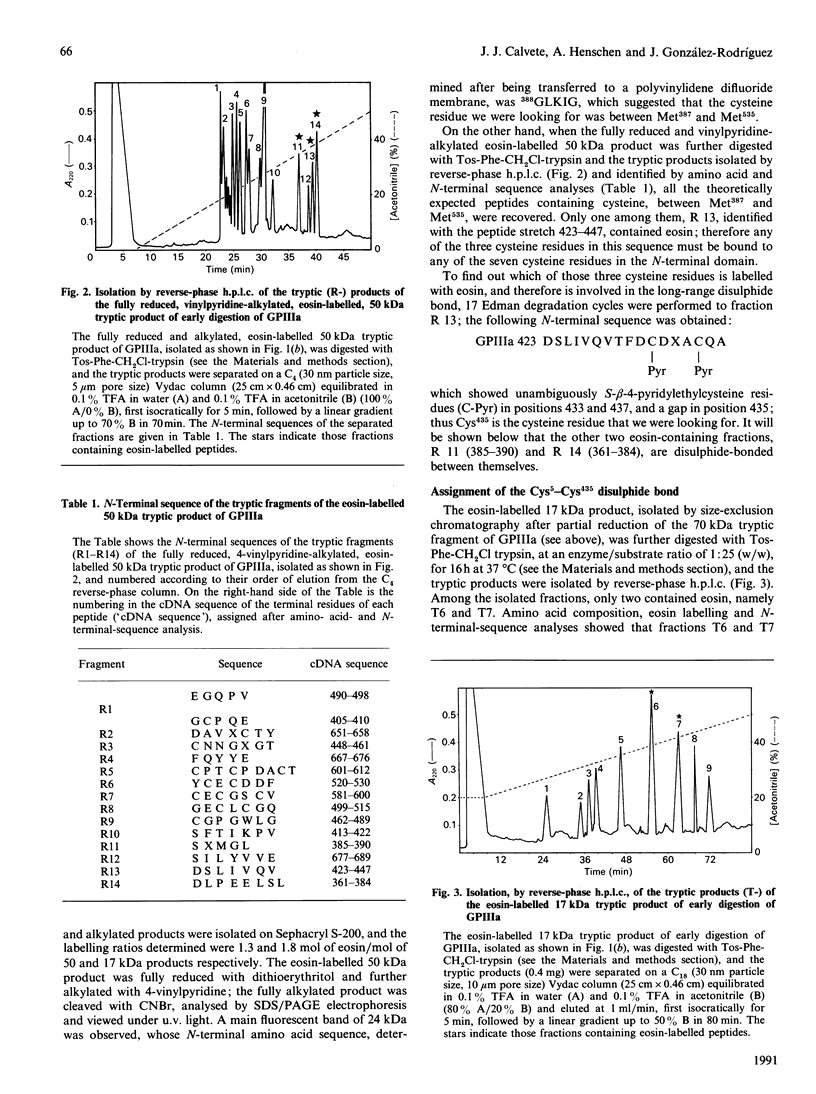
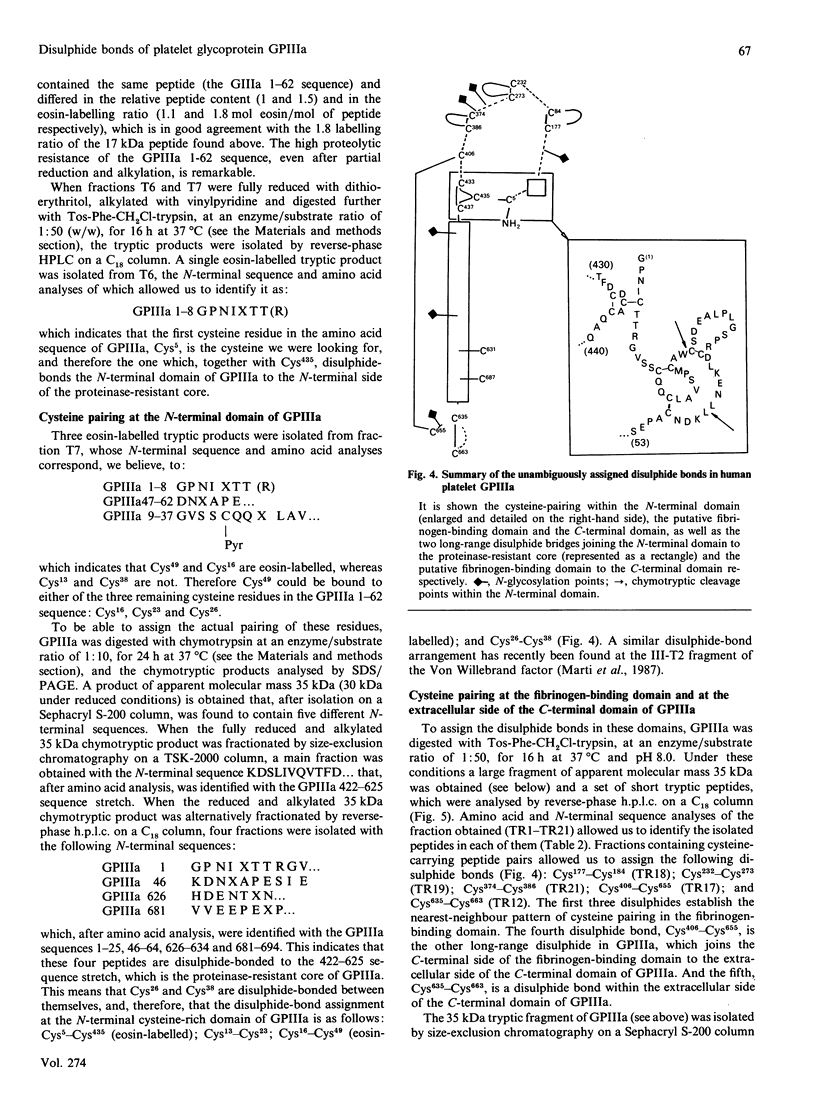

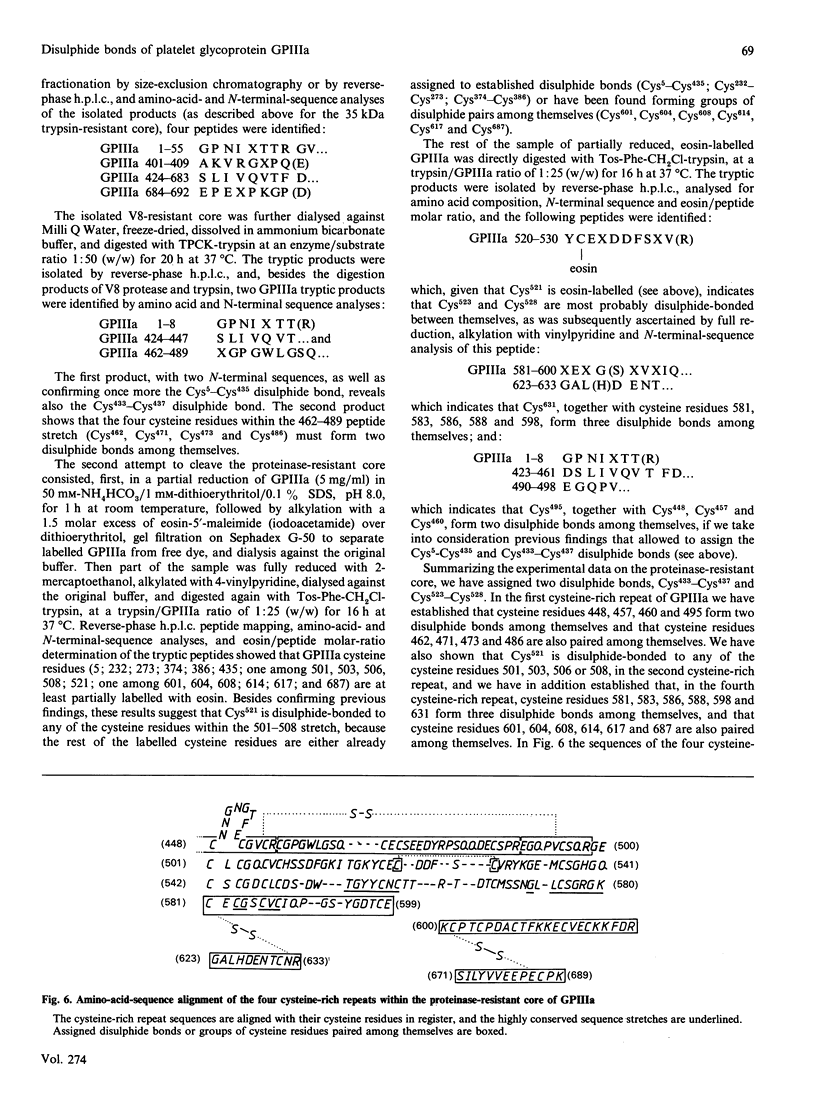
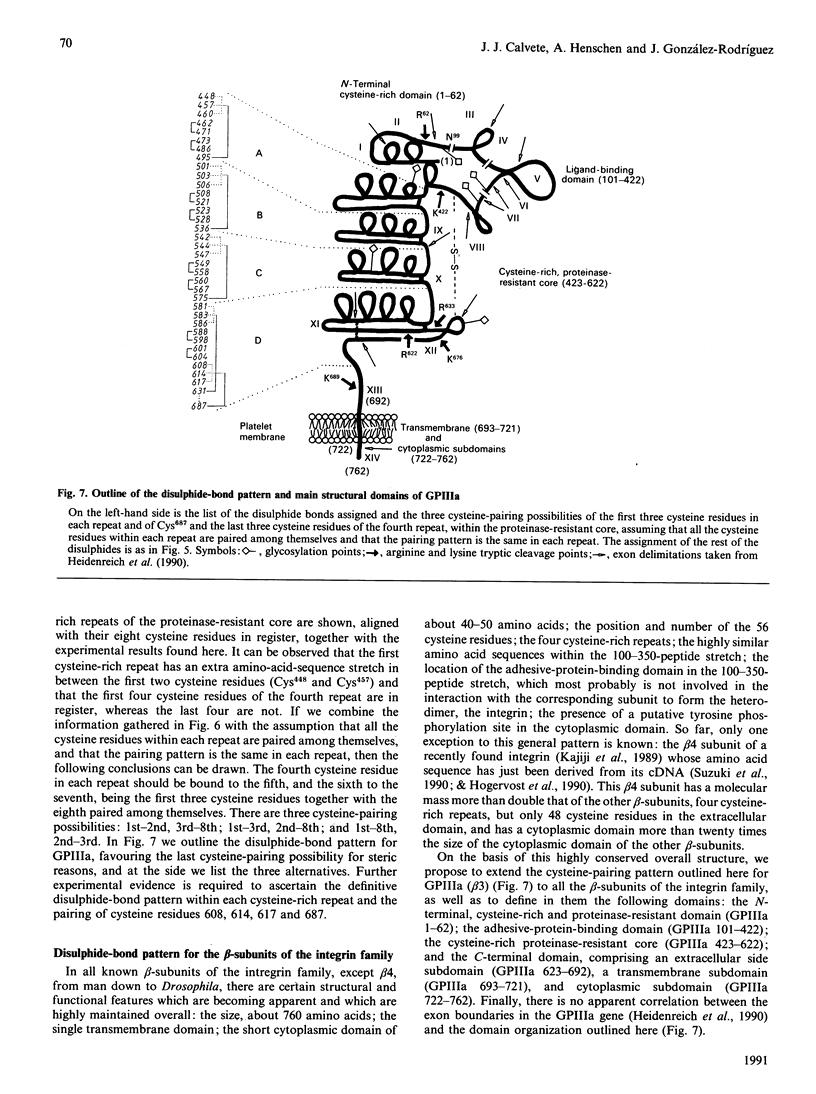

Images in this article
Selected References
These references are in PubMed. This may not be the complete list of references from this article.
- Beer J., Coller B. S. Evidence that platelet glycoprotein IIIa has a large disulfide-bonded loop that is susceptible to proteolytic cleavage. J Biol Chem. 1989 Oct 15;264(29):17564–17573. [PubMed] [Google Scholar]
- Bennett J. S., Vilaire G., Cines D. B. Identification of the fibrinogen receptor on human platelets by photoaffinity labeling. J Biol Chem. 1982 Jul 25;257(14):8049–8054. [PubMed] [Google Scholar]
- Calvete J. J., Henschen A., González-Rodríguez J. Complete localization of the intrachain disulphide bonds and the N-glycosylation points in the alpha-subunit of human platelet glycoprotein IIb. Biochem J. 1989 Jul 15;261(2):561–568. doi: 10.1042/bj2610561. [DOI] [PMC free article] [PubMed] [Google Scholar]
- Calvete J. J., Rivas G., Maruri M., Alvarez M. V., McGregor J. L., Hew C. L., Gonzalez-Rodriguez J. Tryptic digestion of human GPIIIa. Isolation and biochemical characterization of the 23 kDa N-terminal glycopeptide carrying the antigenic determinant for a monoclonal antibody (P37) which inhibits platelet aggregation. Biochem J. 1988 Mar 15;250(3):697–704. doi: 10.1042/bj2500697. [DOI] [PMC free article] [PubMed] [Google Scholar]
- Calvete J. J., Schäfer W., Henschen A., Gonzalez-Rodriquez J. C-terminal amino acid determination of the transmembrane subunits of the human platelet fibrinogen receptor, the GPIIb/IIIa complex. FEBS Lett. 1990 Apr 9;263(1):43–46. doi: 10.1016/0014-5793(90)80701-j. [DOI] [PubMed] [Google Scholar]
- Calvete J. J., Schäfer W., Henschen A., González-Rodríguez J. Characterization of the beta-chain N-terminus heterogeneity and the alpha-chain C-terminus of human platelet GPIIb. Posttranslational cleavage sites. FEBS Lett. 1990 Oct 15;272(1-2):37–40. doi: 10.1016/0014-5793(90)80443-m. [DOI] [PubMed] [Google Scholar]
- Cheresh D. A. Human endothelial cells synthesize and express an Arg-Gly-Asp-directed adhesion receptor involved in attachment to fibrinogen and von Willebrand factor. Proc Natl Acad Sci U S A. 1987 Sep;84(18):6471–6475. doi: 10.1073/pnas.84.18.6471. [DOI] [PMC free article] [PubMed] [Google Scholar]
- Cheresh D. A., Spiro R. C. Biosynthetic and functional properties of an Arg-Gly-Asp-directed receptor involved in human melanoma cell attachment to vitronectin, fibrinogen, and von Willebrand factor. J Biol Chem. 1987 Dec 25;262(36):17703–17711. [PubMed] [Google Scholar]
- D'Souza S. E., Ginsberg M. H., Burke T. A., Lam S. C., Plow E. F. Localization of an Arg-Gly-Asp recognition site within an integrin adhesion receptor. Science. 1988 Oct 7;242(4875):91–93. doi: 10.1126/science.3262922. [DOI] [PubMed] [Google Scholar]
- Eirín M. T., Calvete J. J., González-Rodríguez J. New isolation procedure and further biochemical characterization of glycoproteins IIb and IIIa from human platelet plasma membrane. Biochem J. 1986 Nov 15;240(1):147–153. doi: 10.1042/bj2400147. [DOI] [PMC free article] [PubMed] [Google Scholar]
- Fitzgerald L. A., Steiner B., Rall S. C., Jr, Lo S. S., Phillips D. R. Protein sequence of endothelial glycoprotein IIIa derived from a cDNA clone. Identity with platelet glycoprotein IIIa and similarity to "integrin". J Biol Chem. 1987 Mar 25;262(9):3936–3939. [PubMed] [Google Scholar]
- Heidenreich R., Eisman R., Surrey S., Delgrosso K., Bennett J. S., Schwartz E., Poncz M. Organization of the gene for platelet glycoprotein IIb. Biochemistry. 1990 Feb 6;29(5):1232–1244. doi: 10.1021/bi00457a020. [DOI] [PubMed] [Google Scholar]
- Hogervorst F., Kuikman I., von dem Borne A. E., Sonnenberg A. Cloning and sequence analysis of beta-4 cDNA: an integrin subunit that contains a unique 118 kd cytoplasmic domain. EMBO J. 1990 Mar;9(3):765–770. doi: 10.1002/j.1460-2075.1990.tb08171.x. [DOI] [PMC free article] [PubMed] [Google Scholar]
- Hynes R. O. Integrins: a family of cell surface receptors. Cell. 1987 Feb 27;48(4):549–554. doi: 10.1016/0092-8674(87)90233-9. [DOI] [PubMed] [Google Scholar]
- Kajiji S., Tamura R. N., Quaranta V. A novel integrin (alpha E beta 4) from human epithelial cells suggests a fourth family of integrin adhesion receptors. EMBO J. 1989 Mar;8(3):673–680. doi: 10.1002/j.1460-2075.1989.tb03425.x. [DOI] [PMC free article] [PubMed] [Google Scholar]
- Laemmli U. K. Cleavage of structural proteins during the assembly of the head of bacteriophage T4. Nature. 1970 Aug 15;227(5259):680–685. doi: 10.1038/227680a0. [DOI] [PubMed] [Google Scholar]
- Lam S. C., Plow E. F., Ginsberg M. H. Platelet membrane glycoprotein IIb heavy chain forms a complex with glycoprotein IIIa that binds Arg-Gly-Asp peptides. Blood. 1989 May 1;73(6):1513–1518. [PubMed] [Google Scholar]
- Markwell M. A., Haas S. M., Bieber L. L., Tolbert N. E. A modification of the Lowry procedure to simplify protein determination in membrane and lipoprotein samples. Anal Biochem. 1978 Jun 15;87(1):206–210. doi: 10.1016/0003-2697(78)90586-9. [DOI] [PubMed] [Google Scholar]
- Marti T., Rösselet S. J., Titani K., Walsh K. A. Identification of disulfide-bridged substructures within human von Willebrand factor. Biochemistry. 1987 Dec 15;26(25):8099–8109. doi: 10.1021/bi00399a013. [DOI] [PubMed] [Google Scholar]
- Matsudaira P. Sequence from picomole quantities of proteins electroblotted onto polyvinylidene difluoride membranes. J Biol Chem. 1987 Jul 25;262(21):10035–10038. [PubMed] [Google Scholar]
- Nachman R. L., Leung L. L. Complex formation of platelet membrane glycoproteins IIb and IIIa with fibrinogen. J Clin Invest. 1982 Feb;69(2):263–269. doi: 10.1172/JCI110448. [DOI] [PMC free article] [PubMed] [Google Scholar]
- Niewiarowski S., Norton K. J., Eckardt A., Lukasiewicz H., Holt J. C., Kornecki E. Structural and functional characterization of major platelet membrane components derived by limited proteolysis of glycoprotein IIIa. Biochim Biophys Acta. 1989 Jul 24;983(1):91–99. doi: 10.1016/0005-2736(89)90384-2. [DOI] [PubMed] [Google Scholar]
- Pasqualini R., Chamone D. F., Brentani R. R. Determination of the putative binding site for fibronectin on platelet glycoprotein IIb-IIIa complex through a hydropathic complementarity approach. J Biol Chem. 1989 Aug 25;264(24):14566–14570. [PubMed] [Google Scholar]
- Plow E. F., McEver R. P., Coller B. S., Woods V. L., Jr, Marguerie G. A., Ginsberg M. H. Related binding mechanisms for fibrinogen, fibronectin, von Willebrand factor, and thrombospondin on thrombin-stimulated human platelets. Blood. 1985 Sep;66(3):724–727. [PubMed] [Google Scholar]
- Poncz M., Eisman R., Heidenreich R., Silver S. M., Vilaire G., Surrey S., Schwartz E., Bennett J. S. Structure of the platelet membrane glycoprotein IIb. Homology to the alpha subunits of the vitronectin and fibronectin membrane receptors. J Biol Chem. 1987 Jun 25;262(18):8476–8482. [PubMed] [Google Scholar]
- Pytela R., Pierschbacher M. D., Ruoslahti E. A 125/115-kDa cell surface receptor specific for vitronectin interacts with the arginine-glycine-aspartic acid adhesion sequence derived from fibronectin. Proc Natl Acad Sci U S A. 1985 Sep;82(17):5766–5770. doi: 10.1073/pnas.82.17.5766. [DOI] [PMC free article] [PubMed] [Google Scholar]
- Ramaswamy H., Hemler M. E. Cloning, primary structure and properties of a novel human integrin beta subunit. EMBO J. 1990 May;9(5):1561–1568. doi: 10.1002/j.1460-2075.1990.tb08275.x. [DOI] [PMC free article] [PubMed] [Google Scholar]
- Rosa J. P., Bray P. F., Gayet O., Johnston G. I., Cook R. G., Jackson K. W., Shuman M. A., McEver R. P. Cloning of glycoprotein IIIa cDNA from human erythroleukemia cells and localization of the gene to chromosome 17. Blood. 1988 Aug;72(2):593–600. [PubMed] [Google Scholar]
- Ruggeri Z. M., De Marco L., Gatti L., Bader R., Montgomery R. R. Platelets have more than one binding site for von Willebrand factor. J Clin Invest. 1983 Jul;72(1):1–12. doi: 10.1172/JCI110946. [DOI] [PMC free article] [PubMed] [Google Scholar]
- Ruoslahti E., Pierschbacher M. D. New perspectives in cell adhesion: RGD and integrins. Science. 1987 Oct 23;238(4826):491–497. doi: 10.1126/science.2821619. [DOI] [PubMed] [Google Scholar]
- Suzuki S., Naitoh Y. Amino acid sequence of a novel integrin beta 4 subunit and primary expression of the mRNA in epithelial cells. EMBO J. 1990 Mar;9(3):757–763. doi: 10.1002/j.1460-2075.1990.tb08170.x. [DOI] [PMC free article] [PubMed] [Google Scholar]
- Thiagarajan P., Kelly K. L. Exposure of binding sites for vitronectin on platelets following stimulation. J Biol Chem. 1988 Feb 25;263(6):3035–3038. [PubMed] [Google Scholar]
- Usobiaga P., Calvete J. J., Saíz J. L., Eirín M. T., González-Rodríguez J. Molecular characterization of human platelet glycoproteins IIIa and IIb and the subunits of the latter. Eur Biophys J. 1987;14(4):211–218. doi: 10.1007/BF00256354. [DOI] [PubMed] [Google Scholar]
- Zimrin A. B., Gidwitz S., Lord S., Schwartz E., Bennett J. S., White G. C., 2nd, Poncz M. The genomic organization of platelet glycoprotein IIIa. J Biol Chem. 1990 May 25;265(15):8590–8595. [PubMed] [Google Scholar]



